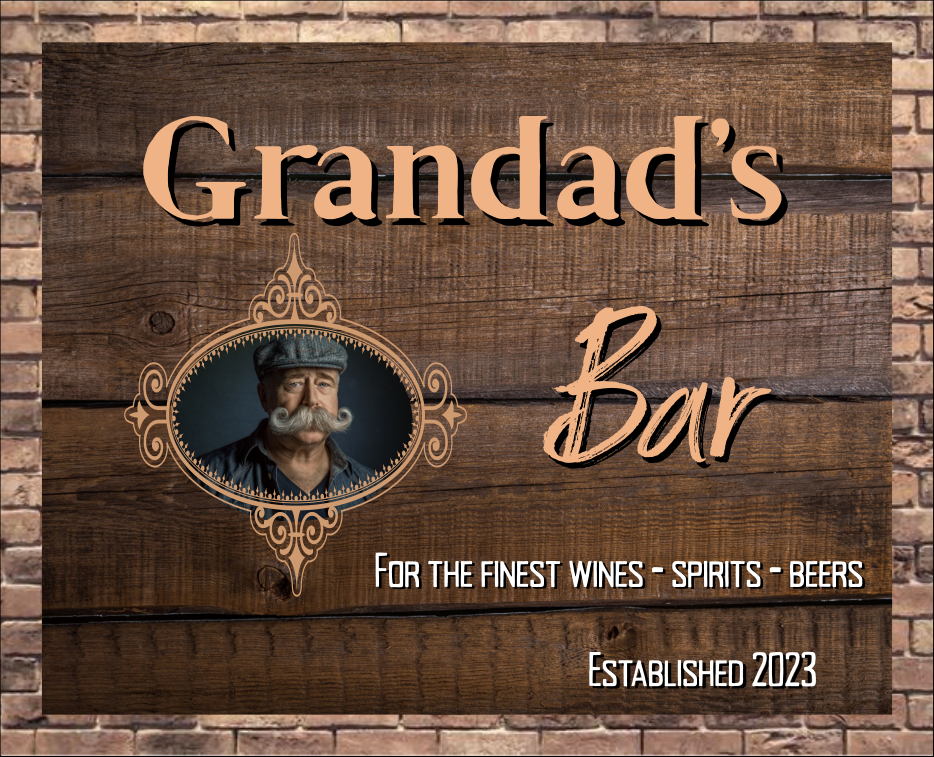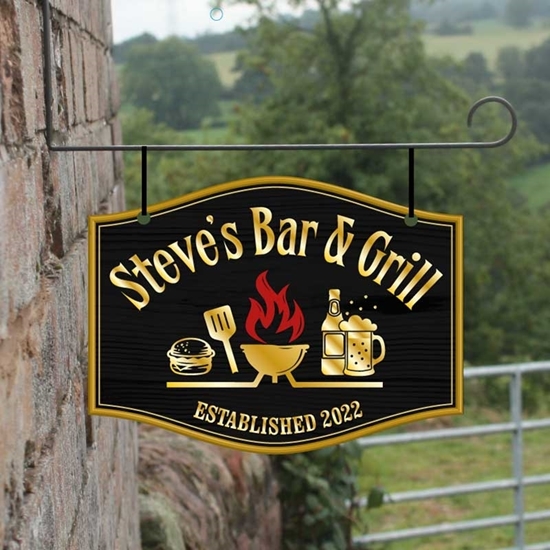Free Reasons On Selecting Man Cave Signs
Wiki Article
How Do Bar Signs Vary In Size?
The dimensions of bar signs vary in accordance with the purpose they're intended for and their position as well as the overall design aesthetic. The following is a breakdown of how the size of bar signs affects their effectiveness and awe. Large Signs
The purpose of the arrow is to attract attention and act as a focal-point.
Uses: Exterior signage, main branding signs, or feature walls.
Location: Usually, it is placed above entrances, along large walls, or in front of the bar to draw in customers.
For instance, large neon signs, or vintage-style or large mural-type signage.
2. Medium Signs
The goal of wall art is to give information and to enhance the decor not taking up space.
Uses: Menu boards and directional signage.
Placement of signage: Ensure that the signage is in a visible location, but not too overwhelming.
A few examples are signs of medium size for daily specials; steel signs with bar's logo or themed decorative signs.
3. Small Signs
The purpose is to add subtle decorative elements or provide specific information.
Uses: Table signs, or small ornaments.
The table or shelves, or in displays in which close-up viewing is expected.
For instance, table number signs, small quotes framed or menus for drinks.
Size Considerations
Visibility
Large signs are designed to attract passersby, and establish the bar’s presence.
Medium Signs They are perfect for balancing visibility with space effectiveness and delivering important information, while not overpowering decor.
Small Signs (small signs): These are ideal for small and intimate information, which can be displayed at eye-level.
Proportion
Large Signs: They must be proportionally large in order so as to not overwhelm smaller spaces. They are best for open and large areas.
Medium Signs - Goes well with most interiors and can be used in a variety of placement.
Small signs are great to add detail and be tucked away in smaller spaces.
Impact
Signs that are large in size makes a bold and imposing statement. This is an important aspect of branding. Most often, they are used to establish the mood of the bar.
Medium Signs: Strikes the perfect balance between décor and visibility and adds to the overall atmosphere while conveying vital information.
Small signs: add interest and detail, resulting in a richer visual experience.
Practicality
Large Signs: These signs require a large amount of mounting equipment, and they are more costly due to their dimensions.
Medium signs offer more flexibility in terms of design and are simpler to install.
Small Signs. Highly versatile, easy to replace and update. Great for busy environments.
Functionality
Large Signs: They are used primarily to increase visibility and attract attention.
Medium Signs are both functional as well decorative. They provide vital information as well as enhance the visual appeal.
Small Signs are primarily functional and provide details. They can also be a part of an overall theme or style.
The ideal size for bar signs is determined by their intended purpose, layout, as well as the impact they have on patrons. Make sure to balance these factors so that the signs contribute to the atmosphere of the bar as well as its operational needs. See the best hanging pub signs for site advice including large pub sign, the pub sign, personalised pub, bar signs for garden, personalised pub, a bar sign, bar sign outdoor, garden bar signs, pub signs to buy, make a bar sign and more.

What Are The Differences Between Bar Signs In Light?
Bar signs differ in their lighting. This impacts visibility, ambience and the impact. Here are some of the most significant ways lighting impacts bar signs. Neon Signs
Characteristics: Bright, colorful, classic.
Lighting: Make use of gas-filled tubes that light up when they are charged electrically.
The uses for this product are It's ideal for creating an old-fashioned or retro vibe.
The nostalgic appeal and high visibility make this a fantastic choice.
The material is brittle and can be costly to fix.
2. LED Signs
Characteristics: Energy-efficient, versatile, modern.
Lighting: LEDs emit bright, vibrant light.
The applications include outdoor and indoor signs, programmable lighting effects and interactive displays.
Benefits include long-lasting and energy efficient. Animations and color changes can be programed.
The initial cost can be expensive, but you'll lower your costs for maintenance and energy.
3. Backlit Signs
Characteristics: Elegant, sophisticated, subtle.
Lighting: A translucent surface is illuminated with fluorescent lights or LEDs to create a soft glowing.
Applications: Typically utilized in modern menu boards, bar signs, and branding elements.
Benefits: Increases the reading ability of smaller print in dim light conditions.
The installation is more complex and the upfront cost is more expensive.
4. Edge-Lit Signs
Characteristics: Sleek, contemporary, stylish.
Lighting: Illuminates the edges of a panel sign (usually acrylic) by using LEDs.
Applications: Modern and minimalist designs.
Advantages Gives a refined and distinctive appearance.
Limitations: Restricted to certain style of design.
5. Ambient/Accent Lighting
Characteristics: Subtle, atmospheric, decorative.
Lighting: Make use of indirect lighting sources to highlight or accentuate indications.
Uses: Enhances the ambiance and is commonly used to highlight artwork or themed decor.
Advantages: It can create an inviting and warm environment.
Disadvantages : Direct illumination may not be enough to read.
6. Marquee signs
Characteristics: Bold, theatrical, eye-catching.
Lighting: Featuring several light bulbs or LEDs around the edges of the sign.
Applications: Great for outdoor signs, event promotions, and creating a vintage cinema-style look.
Highly visible and attractive.
The disadvantages are that it is costly and requires frequent maintenance.
7. Projection signs
Characteristics: Dynamic, innovative, versatile.
Lighting Projectors project light and images on surfaces.
Uses : Perfect for promotions that are temporary, special events, and for dynamic displays.
Advantages: Easy to change and there is no structure is needed.
Advantages
8. Fluorescent Signs
Characteristics: Bright, cost-effective, traditional.
Lighting Tubes with fluorescent light sources are used to light.
Applications: Typically used to create large indoor and outdoor signs.
Large signs are attractive and bright and reasonably priced.
Advantages: More energy-efficient than LEDs, can have harsher lighting.
Lighting Considerations
Visibility
Neon and LED signposts: Great for grabbing your attention from an extended distance.
Edge lit and backlit signs are excellent for improving the readability as well as creating an attractive appearance.
Energy Efficiency
LED signs: Energy efficient and long-lasting.
Neon and fluorescent signs are less energy efficient, with neon signs being more fragile.
Aesthetic Appeal
Neon and Marquee Signs: Ideal for retro and vintage aesthetics.
The ideal option for modern and clean designs is edge-lit signage with backlighting.
Ambient Lighting: Improves the general atmosphere and ambience.
Maintenance
LED Signs - Low Maintenance and Durable
Neon signs and fluorescent signs They require a more regular maintenance and possible repairs.
Cost
Backlit and LED signs Costs of initial investment, but less operational expenses.
The initial cost of fluorescent signs is lower however they are more costly in terms of energy costs over time.
Flexibility
The versatility of LED signs and projections allows for the creation of dynamic and evolving content.
Traditional Signs - Less flexible However, they often provide the desired look.
Select the appropriate type of lighting for your bar signage to enhance visibility, create a welcoming environment, and effectively promote your company's name and message. Take a look at the top rated bar runners for blog tips including hanging pub signs personalised, signs for the bar, home pub signs, novelty bar signs, pub signs for garden, garden pub signs, hanging tavern sign, pub bar signs, pub signs for garden, bar sign outdoor and more.

What Are The Differences In Bar Signposts That Pertain To Interactivity?
There are different kinds of interactivity that could be used on bar signs to increase the customer experience and engagement. Below is how bar signs differ in the realm of interactivity. Static Signs
Static signs display information in an unchanging format.
Common types are: printed posters or painted murals.
2. Digital Displays
Digital signs are capable of showing live-time content, including animations, multimedia and updates.
Displays with touchscreens offer interactive content, for example games or promotional materials.
Benefits: Engage patrons, capture attention and deliver relevant information.
3. QR Codes
QR Codes can link directly to social media profiles or menus.
Benefits: Give easy access to additional information such as promotions, news, or loyalty programs.
4. LED Screens
Dynamic Messaging: LED screens can display scrolling text, animations or video clips.
LCDs with touch-enabled touchscreens permit users to interact with their content. This includes choosing menu options, or playing games.
Benefits: Draw attention, communicate information clearly and create an immersive experience.
5. Projection Mapping
Immersive Experiences Projection mapping transforms surfaces providing interactive visuals as well as the ability to tell stories.
Interactivity - Patrons are able to interact with projected elements like interactive games or virtual experiences.
Benefits : Increase the ambience, provide memorable experiences and encourage social interaction.
6. Augmented Reality
Enhanced Reality: AR overlays digital content onto the physical world offering immersive experiences.
AR-enabled Signs: AR signs allow customers to interact and see virtual components like cocktails, or play virtual games.
Benefits: Provide unique experiences, engage patrons, and differentiate the bar from its competitors.
7. Motion Sensors
Responsive Signage: Motion sensors detect movements and trigger interactive responses on signage.
Signs are interactive and can respond to the movements of people using animated content, changing its contents, or displaying personalized messages.
Benefits include: Increasing engagement, creating immersive environments and enthralling patrons with unexpected and exciting experiences.
8. Social Media Integration
Internet Interaction: Posters with hashtags, or handles for social media may stimulate online interaction among patrons.
User-Generated Content: Encourage patrons on social media to share images of bar signs to increase their reach and visibility.
Benefits: Increase the involvement of communities, boost brand recognition, and produce user-generated content.
9. Interactive Lighting
Dynamic Effects: LED or neon signs that have interactive lighting are able to respond to sound, touch, or motion.
Signs are interactive and can change the colors, brightness levels, or patterns, depending on how people interact with them or with the surrounding.
Benefits Create immersive environments and improve ambiance. Captivate your guests' attention.
10. Gamification
Signs with challenges or games with interactive elements are designed to entertain and engage customers.
Reward: Give discounts or other incentives for players who meet challenges or who win games.
Benefits: Encourage frequent visits, boost the duration of stay and encourage social interaction.
Bar owners who incorporate interactive elements into their signage will create an engaging experience that will capture customers' attention, enhance the visibility of their brand and differentiate them in a highly competitive market. See the best twofb.com bar signs for website examples including personalised sign for bar, pub sign design ideas, bar signs for garden, bespoke bar signs, personalised hanging bar sign, outdoor home bar signs, hanging pub signs personalised, hanging pub signs, make your own bar sign, bar wall signs and more.
